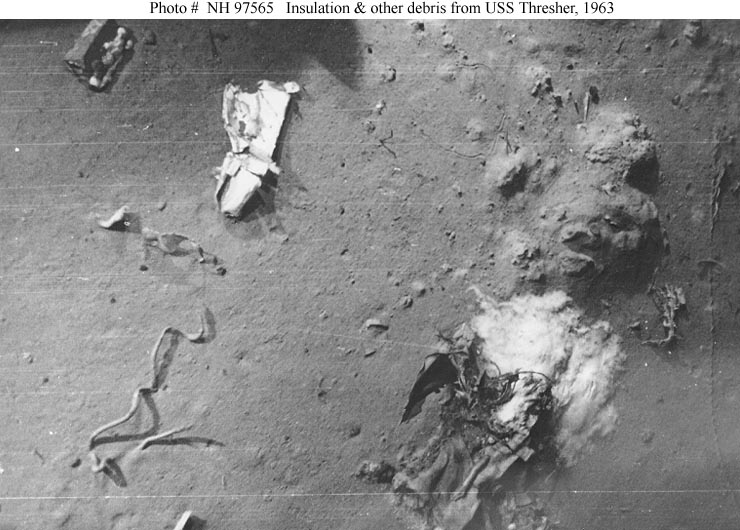
Posted on 06/21/2023 1:27:46 PM PDT by Red Badger
MULTIPLE VIDEOS AT LINK.........
An extensive search-and-rescue has entered its third day trying to locate a submersible that went missing during a dive to the Titanic shipwreck, and time is running out.
Rescuers have been racing against the clock because even under the best of circumstances, the vessel, OceanGate Expedition’s Titan, could run out of oxygen as soon as Thursday morning.
A glimmer of hope came Wednesday morning, when the U.S. Coast Guard (USCG) said in a statement that a Canadian aircraft had detected noises underwater.
The statement did not elaborate on what rescuers believe the noises could be. In underwater disasters, a crew unable to communicate with the surface relies on banging on their submersible’s hull to be detected by sonar. However, no official has publicly suggested that’s the case and noises underwater can come from a variety of sources.
While it’s too early to say what has happened to the Titan, experts have offered insight into some of the most likely scenarios.
A power failure
According to OceanGate’s website, the Titan has an acoustic link with its surface vessel, the Canadian icebreaker Polar Prince, which communicates using a transponder on its end and a transceiver on the receiving end. This link allows for underwater acoustic positioning, and for short text messages to be sent between the two vessels — usually basic status information.
Given that the Titan is a battery-operated submersible and has lost all contact with its surface vessel, it may have lost power. While these types of vessels typically have an emergency backup power source, it’s unclear if the Titan had an independent battery.
OceanGate warned of potential ‘catastrophic’ problems with tourist submersible: NYT report A power failure is considered the best-case scenario for the 20,000-pound Titan. Experts have said that if the submersible’s inbuilt safety system is operating properly, there’s a chance the vessel could drop additional weight and return to the water’s surface.
Some have said there’s a chance that the Titan has surfaced and is bobbing on top of the water already, and it’s just a matter of time until it’s spotted by rescue crews.
The bad news is if the passengers are stranded on top of the water, they remain out of luck until someone finds them; as CBS News journalist David Pogue told the BBC, passengers are sealed inside the vessel’s main capsule with no way of getting out.
A view inside the Titan, with crew members from a previous expedition.View image in full screen A view inside the Titan, with crew members from a previous expedition. OceanGate Expeditions. He recalled from his close-up of the Titan last November that the passengers are sealed into the sub before they begin their expedition. Crews apply more than a dozen heavy bolts from the outside, which must be removed by an external crew in order to exit.
A tangled situation
There is also a chance that the Titan is snagged on something in the water — perhaps a piece of the shipwreck or a large fishing net.
The wreckage of the Titanic, which came to rest approximately four kilometres below the ocean’s surface, is a hazardous area with debris everywhere.
“There are parts of it all over the place. It’s dangerous,” said Frank Owen, a retired Royal Australian Navy official and submarine escape and rescue project director, in an interview with The Guardian.
Crews racing to find missing Titanic tourist submersible: ‘It would be a miracle if they’re recovered alive’ Because the vessel lost contact at one hour and 45 minutes into its trip, the crew may have been close to or at the bottom of the ocean, Owen said.
A failure in pressure
The worst-case scenario is that there has been a leak or damage to the Titan’s pressure hull.
Ian Ballantyne, the editor of International Warships Fleet Review magazine, told the U.K.’s Express publication that “if they suffered a hull rupture the craft and its occupants will likely have swiftly met their end.
“If the craft has retained hull integrity along with air plus power to maintain life support systems, there may be a chance … though submarine rescue beyond the continental shelf is unheard of even in the military,” he continued.
The Titan travels rough waters to get to a previous dive location. OceanGate Expeditions “If it has gone down to the seabed and can’t get back up under its own power, options are very limited,” said Alistair Greig, a professor of marine engineering at University College London.
“While the submersible might still be intact, if it is beyond the continental shelf, there are very few vessels that can get that deep, and certainly not divers.”
Pogue said the vessel’s resurfacing capabilities would be irrelevant if the sub became trapped or sprang a leak.
“There’s no backup, there’s no escape pod,” he said. “It’s get to the surface or die.”
A complex operation, regardless
In any scenario, the operation to locate and retrieve the Titan is complicated and faces a large set of factors that make it a difficult operation.
Because crews do not know if the vessel has surfaced, they must scour both the ocean’s surface and depths, which are both massive in terms of the search area.
Missing Titanic sub: ‘Improvised’ nature of vessel highlighted in 2022 CBS News segment
Chris Parry, a retired rear admiral with the British Royal Navy, told Sky News a seabed rescue was “a very difficult operation.”
“The actual nature of the seabed is very undulating. Titanic herself lies in a trench. There’s lots of debris around. So trying to differentiate with sonar in particular and trying to target the area you want to search in with another submersible is going to be very difficult indeed.”
The ocean’s temperature, weather and sea conditions and visibility above and below the water are also factors that can impact the search.
Aaron Newman, who has been a passenger on the Titan, told NBC’s Today that if the submersible is below a couple hundred metres and without power, the passengers are in complete darkness and it’s cold.
This Global News graphic shows the distance between St. John’s, N.L., and the last point of contact with Titan, an OceanGate Expeditions that went missing Sunday. Global News graphic “It was cold when we were at the bottom,” he said. “You had layered up. You had wool hats on and were doing everything to stay warm at the bottom.”
David Gallo, a senior advisor for strategic initiatives at RMS Titanic, told CNN that dwindling oxygen levels and fighting the cold were the primary concerns for the passengers’ safety at this point.
“The water is very deep — two miles-plus,” Gallo said. “It’s like a visit to another planet. It’s not what people think it is. It is a sunless, cold environment and high pressure.”
In addition to an international array of ships and planes, an underwater robot has begun searching in the vicinity of the Titanic and there is a push to get salvage equipment to the scene in case the sub is found.
Lost aboard the vessel is pilot Stockton Rush, the CEO of the company leading the expedition. His passengers are a British adventurer, two members of a Pakistani business family and a Titanic expert.
Our Subhunter aircraft are the Lockheed P-3 Orion(turboprop) and its successor the Boeing P-8 Poseidon (turbofan).
Whales dive: true enough but they are “free divers.” Their body absorbs the water pressure and they’re built to not be bothered by the Bends when they come back up. Humans can free dive to maybe 300 feet, but are limited to maybe two minutes so’s they don’t absorb high pressure nitrogen.
Or maybe the Japanese, Chicoms or Koreans snagged it in a Trawler Net and they are trying to figure out how to clean and cook it or make Sushi.
On a serious note I hope that each of them has been in contact with Their God🙏
They’re dead, Jim.
Stupid is as stupid does.
We already had that proof from George Soros & Bill Gates.
You got it! Just what I’ve been thinking while reading all these lost sub articles all over the place:
“This search and rescue is all for show, the ultimate virtue signaling while Hunter Biden is freed and President Trump is indicted.”
This fruitless search and rescue is just one big distraction. If the sub is intact at all, it could have drifted miles from its initial location. It may not be found for years, if in tact.
They need to find it so that they estates of these people won’t be tied up for 7 years.
Were they issued Red Star Trek shirts before the trip?
i figured catastrophic failure, much surprised to hear the banging...
their little light went out long ago

I’ve been seeing people all day on these forums who’ve never heard of a sonar buoy. Submarine hunters being aircraft is obvious.
The door is made of titanium.
I suspect sub detection equipment used by the military is very very good at picking up these types of sounds. Sound does travel differently underwater.
But it could be anything banging around down there. I did hear it was happening every 30 minutes though. Natural sounds would not happen every 30 minutes. They would be random.
If structural failure occurred it was over before instantly. Not even time realize or think about.

But yes in all seriousness I agree that this has become Their final destination.
It also would likely blast right through the other side of the craft.
Destruction would happen quickly
Me and a coworker were discussing that very thing today. While I pray for their safe rescue, I’d rather a hull crush than slowly running out of air in a black tomb and suffocating with 5 panicked people in a space no bigger than the inside of an economy car. It’s like being buried alive. A hull implosion would be a much more merciful death.
much assholery
Compounded by the fact that powerless vessels are going to be drifting with the currents meaning that the search area is ever expanding.
The entombed potential scenario is hard to contemplate for very long when thinking about their situation.
If it were drifting on surface, would it show up on radar or something?
Disclaimer: Opinions posted on Free Republic are those of the individual posters and do not necessarily represent the opinion of Free Republic or its management. All materials posted herein are protected by copyright law and the exemption for fair use of copyrighted works.